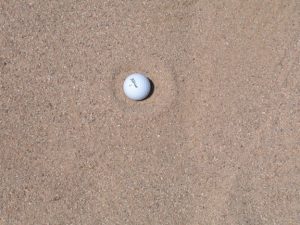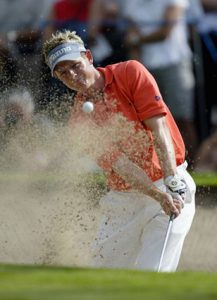A Sand Lesson from Number One

By Dr. T. J. Tomasi, Keiser University College of Golf Senior Faculty and Director of Research
Being a good sand player involves adjusting your technique to the lie that you are dealt in the bunker. In the photos below, Luke Donald, once ranked number one in the world, has a challenging lie because his ball is half buried in the sand.
In normal sand shots, you need to make sure you finish with a high follow-through that keeps the clubhead moving through the sand, but with this “medium fried egg,” you do just the opposite – take a lot more sand with limited follow-through. Because this action spits the ball out low and running, Donald must make a plan based on how much green he has to work with. If the pin is tight, he needs to play away from the hole into the center of the green.
On this occasion, Donald has about 30 feet to the pin, so he will blast and run it directly to the hole. His ball ended up fried because he got aggressive and hit a towering short iron that was knocked out of the sky when a gust of wind caught it.
Here is what you can learn from his mistake: When the wind is blowing in your face, and you’re coming in over a bunker, take care to hit a little extra club – otherwise, your ball will balloon and come straight down into a buried lie.

To prepare for the “fried egg,” you must first consider the texture of the sand. Wet sand can fool you since it’s compacted and heavy with water, so it transmits energy to the ball very efficiently, meaning the ball will squirt and then run when it hits the green. It’s just the opposite when you’re faced with dry, heavy beach sand that absorbs the blow, forcing you to blast your ball out with much more force.
To pull off the blast and run shot, Donald positions the ball off his left logo with his spine inclined toward the target to promote a downward strike. He anchors his weight on his front foot to swing the club up steeply and drop it firmly behind the ball. When doing this, you should feel like your head and weight are ahead of the ball. The trick is to hit down into the sand to make the ball pop out. The danger if you try to help the ball out with a lifting motion is that the ball may stay in the bunker.
Things to note:
- His hands and arms are moving directly across his body as if they were trying to get into his left pocket.
- His left arm is pointed at the ground and won’t travel much higher than it is now.
- His right arm is fully extended.
- He is taking a large amount of sand.
- His forearms don’t roll over.

The College of Golf at Keiser University can help. With PGA professionals on staff and state-of-the-practice technology available to our students, we can prepare you for the golf career of your dreams. Contact us today for more information.














